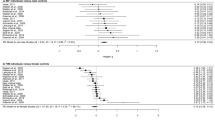Abstract
From early childhood, gender identity and the 2nd to 4th finger length ratio (2D:4D) are discriminative characteristics between sexes. Both the human brain and 2D:4D may be influenced by prenatal testosterone levels. This calls for an examination of 2D:4D in patients with gender identity disorder (GID) to study the possible influence of prenatal testosterone on gender identity. Until now, the only study carried out on this issue suggests lower prenatal testosterone levels in right-handed male-to-female GID patients (MtF). We compared 2D:4D of 56 GID patients (39 MtF; 17 female-to-male GID patients, FtM) with data from a control sample of 176 men and 190 women. Bivariate group comparisons showed that right hand 2D:4D in MtF was significantly higher (feminized) than in male controls, but similar to female controls. The comparison of 2D:4D ratios of biological women revealed significantly higher (feminized) values for right hands of right handed FtM. Analysis of variance confirmed significant effects for sex and for gender identity on 2D:4D ratios but not for sexual orientation or for the interaction among variables. Our results indirectly point to the possibility of a weak influence of reduced prenatal testosterone as an etiological factor in the multifactorially influenced development of MtF GID. The development of FtM GID seems even more unlikely to be notably influenced by prenatal testosterone.

Similar content being viewed by others
References
Baum, M. J. (1979). Differentiation of coital behavior in mammals: A comparative analysis. Neuroscience & Biobehavioral Reviews, 3, 265–284.
Becker, S., Bosinski, H. A., Clement, U., Elcher, W., Goerlich, T. M., Hartmann, U., et al. (1997). Standards in treatment and assessment of transsexual patients. German Society of Sexual Research, Academy of Sexual Medicine and Society of Sexual Science. Zentralblatt für Gynäkologie, 119, 398–401.
Blanchard, R. (1985). Typology of male-to-female transsexualism. Archives of Sexual Behavior, 14, 247–261.
Blanchard, R. (1988). Nonhomosexual gender dysphoria. Journal of Sex Research, 24, 188–193.
Blanchard, R. (1989). The concept of autogynephilia and the typology of male gender dysphoria. Journal of Nervous and Mental Disease, 177, 616–623.
Brown, W. M., Finn, C. J., Cooke, B. M., & Breedlove, S. M. (2002). Differences in finger length ratios between self-identified “butch” and “femme” lesbians. Archives of Sexual Behavior, 31, 123–127.
Cooke, B., Hegstrom, C. D., Villeneuve, L. S., & Breedlove, S. M. (1998). Sexual differentiation of the vertebrate brain: Principles and mechanisms. Frontiers in Neuroendocrinology, 19, 323–362.
Gooren, L. (2006). The biology of human psychosexual differentiation. Hormones and Behavior, 50, 589–601.
Gooren, L. J., & Kruijver, F. P. (2002). Androgens and male behavior. Molecular and Cellular Endocrinology, 198, 31–40.
Hepp, U., & Buddeberg, C. (1999). Assessment and treatment of transsexualism. Schweizerische Rundschau für Medizin Praxis, 88, 1975–1979.
Kraemer, B., Noll, T., Delsignore, A., Milos, G., Schnyder, U., & Hepp, U. (2006). Finger length ratio (2D:4D) and dimensions of sexual orientation. Neuropsychobiology, 53, 210–214.
Lippa, R. A. (2003). Are 2D:4D finger-length ratios related to sexual orientation? Yes for men, no for women. Journal of Personality and Social Psychology, 85, 179–188.
Manning, J. T., Churchill, A. J., & Peters, M. (2007). The effects of sex, ethnicity, and sexual orientation on self-measured digit ratio (2D:4D). Archives of Sexual Behavior, 36, 223–233.
Manning, J. T., Scutt, D., Wilson, J., & Lewis-Jones, D. I. (1998). The ratio of 2nd to 4th digit length: A predictor of sperm numbers and concentrations of testosterone, luteinizing hormone and oestrogen. Human Reproduction, 13, 3000–3004.
McFadden, D., Loehlin, J. C., Breedlove, S. M., Lippa, R. A., Manning, J. T., & Rahman, Q. (2005). A reanalysis of five studies on sexual orientation and the relative length of the 2nd and 4th fingers (the 2D:4D ratio). Archives of Sexual Behavior, 34, 341–356.
McFadden, D., & Shubel, E. (2002). Relative lengths of fingers and toes in human males and females. Hormones and Behavior, 42, 492–500.
Migeon, C. J., & Wisniewski, A. B. (1998). Sexual differentiation: From genes to gender. Hormone Research, 50, 245–251.
Peters, M., Mackenzie, K., & Bryden, P. (2002). Finger length and distal finger extent patterns in humans. American Journal of Physical Anthropology, 117, 209–217.
Rahman, Q., & Wilson, G. D. (2003). Sexual orientation and the 2nd to 4th finger length ratio: Evidence for organising effects of sex hormones or developmental instability? Psychoneuroendocrinology, 28, 288–303.
Robinson, S. J., & Manning, J. T. (2000). The ratio of 2nd to 4th digit length and male homosexuality. Evolution and Human Behavior, 21, 333–345.
Schneider, H. J., Pickel, J., & Stalla, G. K. (2006). Typical female 2nd−4th finger length (2D:4D) ratios in male-to-female transsexuals-possible implications for prenatal androgen exposure. Psychoneuroendocrinology, 31, 265–269.
Smith, Y. L. S., van Goozen, S. H. M., Kuiper, A. J., & Cohen-Kettenis, P. T. (2005). Transsexual subtypes: Clinical and theoretical significance. Psychiatry Research, 137, 151–160.
Tanner, J. (1990). Fetus into man: Physical growth from conception to maturity. Cambridge: Harvard University Press.
Voracek, M., Manning, J. T., & Ponocny, I. (2005). Digit ratio (2D:4D) in homosexual and heterosexual men from Austria. Archives of Sexual Behavior, 34, 335–340.
Williams, T. J., Pepitone, M. E., Christensen, S. E., Cooke, B. M., Huberman, A. D., Breedlove, N. J., et al. (2000). Finger-length ratios and sexual orientation. Nature, 404, 455–456.
Acknowledgment
The authors would like to thank the Editor for assistance in the preparation of this article.
Author information
Authors and Affiliations
Corresponding author
Rights and permissions
About this article
Cite this article
Kraemer, B., Noll, T., Delsignore, A. et al. Finger Length Ratio (2D:4D) in Adults with Gender Identity Disorder. Arch Sex Behav 38, 359–363 (2009). https://doi.org/10.1007/s10508-007-9262-4
Received:
Revised:
Accepted:
Published:
Issue Date:
DOI: https://doi.org/10.1007/s10508-007-9262-4




